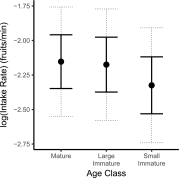Trichromacy increases fruit intake rates of wild capuchins (Cebus capucinus imitator)
- PMID: 28894009
- PMCID: PMC5625910
- DOI: 10.1073/pnas.1705957114
Trichromacy increases fruit intake rates of wild capuchins (Cebus capucinus imitator)
Abstract
Intraspecific color vision variation is prevalent among nearly all diurnal monkeys in the neotropics and is seemingly a textbook case of balancing selection acting to maintain genetic polymorphism. Clear foraging advantages to monkeys with trichromatic vision over those with dichromatic "red-green colorblind" vision have been observed in captive studies; however, evidence of trichromatic advantage during close-range foraging has been surprisingly scarce in field studies, perhaps as a result of small sample sizes and strong impacts of environmental or individual variation on foraging performance. To robustly test the effects of color vision type on foraging efficiency in the wild, we conducted an extensive study of dichromatic and trichromatic white-faced capuchin monkeys (Cebus capucinus imitator), controlling for plant-level and monkey-level variables that may affect fruit intake rates. Over the course of 14 months, we collected behavioral data from 72 monkeys in Sector Santa Rosa, Costa Rica. We analyzed 19,043 fruit feeding events within 1,602 foraging bouts across 27 plant species. We find that plant species, color conspicuity category, and monkey age class significantly impact intake rates, while sex does not. When plant species and age are controlled for, we observe that trichromats have higher intake rates than dichromats for plant species with conspicuously colored fruits. This study provides clear evidence of trichromatic advantage in close-range fruit feeding in wild monkeys. Taken together with previous reports of dichromatic advantage for finding cryptic foods, our results illuminate an important aspect of balancing selection maintaining primate opsin polymorphism.
Keywords: color vision; frugivory; opsin genes; platyrrhine; sensory ecology.
Conflict of interest statement
The authors declare no conflict of interest.
Figures




Similar articles
-
Trichromatic perception of flower colour improves resource detection among New World monkeys.Sci Rep. 2018 Jul 18;8(1):10883. doi: 10.1038/s41598-018-28997-4. Sci Rep. 2018. PMID: 30022096 Free PMC article.
-
Sugar concentration of fruits and their detection via color in the Central American spider monkey (Ateles geoffroyi).Am J Primatol. 2005 Dec;67(4):411-23. doi: 10.1002/ajp.20196. Am J Primatol. 2005. PMID: 16342072
-
Food search through the eyes of a monkey: a functional substitution approach for assessing the ecology of primate color vision.Vision Res. 2013 Jun 28;86:87-96. doi: 10.1016/j.visres.2013.04.013. Epub 2013 May 3. Vision Res. 2013. PMID: 23643907
-
Fruits, foliage and the evolution of primate colour vision.Philos Trans R Soc Lond B Biol Sci. 2001 Mar 29;356(1407):229-83. doi: 10.1098/rstb.2000.0773. Philos Trans R Soc Lond B Biol Sci. 2001. PMID: 11316480 Free PMC article. Review.
-
Anointing variation across wild capuchin populations: a review of material preferences, bout frequency and anointing sociality in Cebus and Sapajus.Am J Primatol. 2012 Apr;74(4):299-314. doi: 10.1002/ajp.20971. Epub 2011 Jul 18. Am J Primatol. 2012. PMID: 21769906 Review.
Cited by
-
Investigation through Animal-Computer Interaction: A Proof-of-Concept Study for the Behavioural Experimentation of Colour Vision in Zoo-Housed Primates.Animals (Basel). 2024 Jul 4;14(13):1979. doi: 10.3390/ani14131979. Animals (Basel). 2024. PMID: 38998091 Free PMC article.
-
Fruit scent and observer colour vision shape food-selection strategies in wild capuchin monkeys.Nat Commun. 2019 Jun 3;10(1):2407. doi: 10.1038/s41467-019-10250-9. Nat Commun. 2019. PMID: 31160592 Free PMC article.
-
Changes in a Cone Opsin Repertoire Affect Color-Dependent Social Behavior in Medaka but Not Behavioral Photosensitivity.Front Genet. 2020 Aug 12;11:801. doi: 10.3389/fgene.2020.00801. eCollection 2020. Front Genet. 2020. PMID: 32903371 Free PMC article.
-
Variation and heritability of retinal cone ratios in a free-ranging population of rhesus macaques.Evolution. 2022 Aug;76(8):1776-1789. doi: 10.1111/evo.14552. Epub 2022 Jul 19. Evolution. 2022. PMID: 35790204 Free PMC article.
-
The evolutionary history and spectral tuning of vertebrate visual opsins.Dev Biol. 2023 Jan;493:40-66. doi: 10.1016/j.ydbio.2022.10.014. Epub 2022 Nov 9. Dev Biol. 2023. PMID: 36370769 Free PMC article. Review.
References
-
- Hiwatashi T, et al. An explicit signature of balancing selection for color-vision variation in new world monkeys. Mol Biol Evol. 2010;27:453–464. - PubMed
-
- Kawamura S, et al. Polymorphic color vision in primates: Evolutionary considerations. In: Hirai H, Imai H, Go Y, editors. Post-Genome Biology of Primates. Springer Japan; Tokyo: 2012. pp. 93–120.
-
- Mollon JD, Bowmaker JK, Jacobs GH. Variations of colour vision in a new world primate can be explained by polymorphism of retinal photopigments. Proc R Soc Lond B Biol Sci. 1984;222:373–399. - PubMed
Publication types
MeSH terms
LinkOut - more resources
Full Text Sources
Other Literature Sources
Medical

